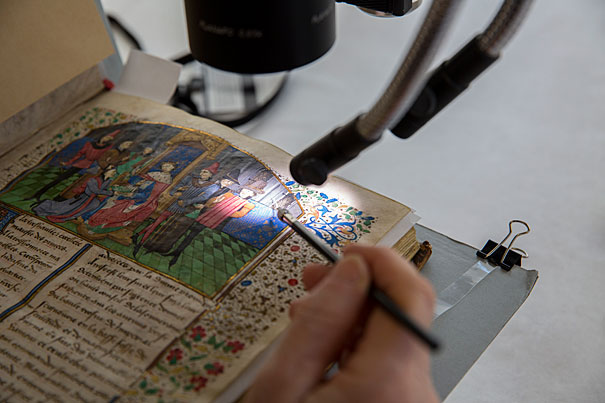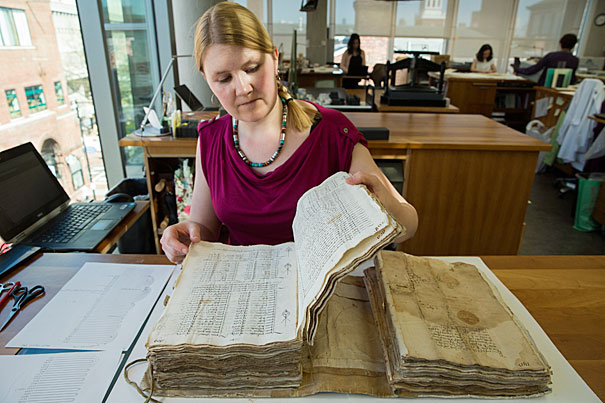
Book conservator Catherine Badot-Costello uses a microscope to work on an illuminated, bound parchment manuscript from Houghton Library.
Jon Chase/Harvard Staff Photographer
Guarding the dazzle of the past
At Weissman Preservation Center, conservators tend to treasures from Harvard libraries
Inside the four-story, glass-and-concrete building near Harvard Square, past busy coffee shops and restaurants, Harvard social clubs, and a flower store, women and men in white ministered to rare books and unique materials from Harvard Library to save them from the ravages of time.
It was a spring afternoon, and specialists at the Weissman Preservation Center labored with a mix of tenderness and skill at the conservation lab on the fourth floor, where entry is restricted. In one corner, Alan Puglia, senior rare book conservator, was mending tears in a letter book kept by an American diplomat during the years of the American Revolution.
Near him, Catherine Badot-Costello, book conservator for special collections, used tiny spatulas to turn the pages of an old photo album from Tozzer Library of the Bakuba, a pre-colonial society in what is now the Democratic Republic of Congo.
Across from her, Christopher Sokolowski, paper conservator for special collections, was using a binocular microscope that can magnify images up to 15 times to find loose layers of paint in an illustrated Bible made in France in the 14th century.
The center, on Mount Auburn Street and named in honor of Paul M. Weissman ’52 and Harriet L. Weissman, preserves rare books, manuscripts, drawings, maps, photographs and other treasures held in repositories across Harvard’s libraries. Its window wall faces north and allows maximum use of natural light.
Last year, conservators took preservation action on 16,000 items, said Brenda Bernier, James Needham Chief Conservator and Head of Weissman Preservation Center and Collections Care. Work included treatment, preparation for exhibition or digital imaging, and repair. But preservation, she said, shouldn’t be confused with restoration.
“If we find a loose page, we’d secure it, but if there’s a loss, we’re not painting that loss,” said Bernier. “We’d stabilize it by adding a material sympathetic in tone, but we wouldn’t try to recreate the image. That’s in the realm of restoration. Our goal is to make these collections stable and usable by students, faculty, and researchers, now and in the future.”
Among the items treated last year were English manor rolls on parchment, 1282 to 1770, from Harvard Law School Library; early 20th-century advertising posters from Radcliffe’s Schlesinger Library; and two ceremonial swords. One of the swords was used by actor Edwin Booth in “Hamlet” and belongs to the Harvard Theatre Collection at Houghton Library. It is currently on exhibition at Houghton’s “Shakespeare: His Collected Works.”


Conservator Katherine Beaty works on a bound volume of business records from Baker Library’s Medici Collection at Harvard Business School. Beaty displays a computistic calendar in the form of a girdle book, dating from 1300 to 1350.
Jon Chase/Harvard Staff Photographer
Keeping old books and rare objects from deterioration requires sophisticated equipment and tools such as brushes, spatulas, and adhesives.
“It’d be a lot easier to put Scotch tape on everything,” said Bernier. “The adhesives we use are old-fashioned, but time-tested. We also use some modern ones, but we want them to be compatible and reversible.”
The conservation lab features tables with built-in suction disks and fume-extraction trunks, allowing conservators to work with solvents. An ultrasonic encapsulator welds pieces of polyester around an object so that it can be safely and easily handled by researchers.
Other objects and materials used by conservators and technicians include tiny scalpels, high-quality brushes, wheat-starch paste for paper mending, Japanese paper tissue, and even paper points, also valued in root canals for their extreme precision.
“Finance gets a big kick out of our supply list because we order things from strange places,” said Bernier. “It could be art supplies, medical supplies, cosmetic supplies such as cosmetic sponges. I’m sure someone is wondering, ‘Why are these people ordering cosmetic sponges?’” The answer: Sponges let conservators collect dust and clean loose soiling from books and other items before they mend tears, an important step in both preserving books and preparing them for digital imaging.
Anne Corrsin, a conservation technician for the Colonial North American Project, was repairing an accounting book from 1739, a corner of which had been chewed on by a mouse.
“This is something very hard to handle for cameras, and even if they do it, it’d slow the work flow,” said Corrsin, with her tools on her table: a small spatula, some Japanese tissue, and a tamping brush.
One challenge for conservators is to repair an object without restoring it. Curators from the library, staff from Harvard Library’s Imaging Services, and a conservator from Weissman get together and recommend a plan of treatment before items are exhibited or digitized.
“We can’t treat whatever we want, however we want,” said Bernier. “There is definitely a dialogue.”
Weissman staff members relish the opportunity to have a glimpse into history and touch objects that haven’t been touched in years.
“They’re all special, for sure,” said Sokolowski, as he examined the 14th-century Bible’s scintillating illustrations. “We try not to get too blasé about it, but it’s one spectacular book after the next.”
Sokolowski applied gelatin to hold the loose paint to the parchment. He seemed pleased with the end result.
“The fabulous gold decoration is not diminished in any way,” he said. “It’s dazzling.”
This week is American Library Preservation Week.



